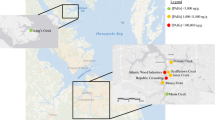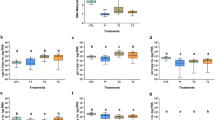Abstract
The aryl hydrocarbon hydroxylase (AHH) activity in eelpout liver microsomes was determined with14C-naphthalene as substrate. The AHH activity changed with the season, peaking in May in both males and females, and did not correlate to water temperature nor time of ovulation. Starvation for one week did not change the AHH activity; starvation for six months increased the activity slightly (p<0.025). Exposure of 0.5 ppm naphthalene in the water for one week or intraperitoneal injection (ip.) of naphthalene in peanut oil (100 mg/kg) did not induce AHH activity in the liver microsomes of adult female eelpouts, which was in contrast to ip. of 5,6-benzoflavone (5,6-BF) (100 mg/kg) which increased the AHH activity three fold. 7,8-benzoflavone (7,8-BF) inhibited the AHH activityin vitro in 5,6-BF induced fish, but it increased the AHH activity in control fish. The AHH activity in the liver microsomes of eelpout embryos shortly before and shortly after parturition was in the same range as in the mother fish.
Similar content being viewed by others
References
Adamson, R. H.: Drug metabolism in marine vertebrates. Fed. Proc.26, 1047 (1967).
Anderson, J. W., J. M. Neff, B. A. Cox, H. E. Tatem, and G. M. Hightower: Characteristics of dispersions and water-soluble extracts of crude and refined oils and their toxicity to estuarine crustaceans and fish. Mar. Biol.27, 75 (1974).
Arcos, J. C., A. H. Conney, and Ng. Buu-Hoi: Induction of microsomal enzyme synthesis by polycyclic aromatic hydrocarbons of different molecular sizes. J. Biol. Chem.236, 1291 (1961).
Armstrong, H. W., K. Fucik, J. W. Anderson, and J. M. Neff: Effects of oilfield brine effluent on sediments and benthic organisms in Trinity Bay, Texas. Mar. Environ. Res.2, 55 (1979).
Bend, J. R., and M. O. James: Xenobiotic metabolism in marine and freshwater species. In D. C. Malins, and J. H. Sargent (eds.): Biochemical and biophysical perspectives in marine biology, vol. IV, p. 125. New York: Academic Press (1978).
Binder, R. L., and J. J. Stegeman: Induction of aryl hydrocarbon hydroxylase activity in embryos of an estuarine fish. Biochem. Pharmac.29, 949 (1980).
Buhler, D. R., and M. E. Rasmussen: The oxidation of drugs by fishes. Comp. Biochem. Physiol.25, 223 (1968).
Campbell, T. C., and J. R. Hayes: Role of nutrition in the drug-metabolizing enzyme system. Pharmacol. Rev.26, 171 (1974).
Creaven, P. J., D. V. Parke, and R. T. Williams: A fluorimetric study of hydroxylation of biphenylin vitro by liver preparations of various species. Biochem. J.96, 879 (1965).
Dewaide, J. H.: Metabolism of xenobiotics. Ph. D. Thesis, University of Nymegen, The Netherlands (1971).
Dowd, J. E., and D. S. Riggs: A comparison of estimates of Michaelis-Menten kinetic constants from various linear transformations. J. Biol. Chem.240, 863 (1965).
Elcombe, C. R., and J. J. Lech: Induction and characterization of hemoprotein P-450 and monooxygenation in rainbow trout (Salmo gairdneri). Toxicol. Appl. Pharmacol.49, 437 (1979).
Garfinkel, D.: Studies on pig liver microsomes. I. Enzymic and pigment composition of different microsomal fractions. Arch. Biochem. Biophys.77, 493 (1958).
Grahl-Nielsen, O.: The Ekofisk Bravo blowout: Petroleum hydrocarbons in the sea. In: Proceedings of the conference on assessment of ecological impacts of oil spills, held in Keystone, Colorado, June 14–17 1978 (1978).
James, M. O., and J. R. Bend: Polycyclic aromatic hydrocarbon induction of cytochrome P-450-dependent mixed-function oxidases in marine fish. Toxicol. Appl. Pharmacol.54, 117 (1980).
Jensen, R.: Fate and effects of naphthalene in the eelpout (Zoarces viviparus (L.)). Cand. Scient. (comparable to M. S.) Dissertation, Odense University, DK-5230 Odense M, Denmark (1981).
Jensen, R., and J. Knudsen: Elimination of14C-naphthalene and its metabolites from embryos of eelpouts after parturition from mother fish exposed to14C-naphthalene in water. In preparation (1983).
Klingenberg, M.: Pigments of rat liver microsomes. Arch. Biochem. Biophys.75, 376 (1958).
Kurelec, B., S. Britvic, M. Rijavec, W. E. G. Müller, and R. K. Zahn: Benzo(a)pyrene monooxygenase induction in marine Fish—Molecular response to oil pollution. Mar. Biol.44, 211 (1977).
Lowry, O. H., N. J. Rosebrough, A. L. Farr, and R. J. Randall: Protein measurement with Folin phenol reagent. J. Biol. Chem.193, 265 (1951).
Melancon, M. J., C. R. Elcombe, M. J. Vodicnik, and J. J. Lech: Induction of cytochromesP450 and mixed-function oxidase activity by polychlorinated biphenyls and Β-naphthoflavone in carp (Cyprinus carpio). Comp. Biochem. Physiol.69C, 219 (1981).
Nilsson, R., E. Peterson, and G. Dallner: A simple procedure for the assay of low levels of aryl hydrocarbon hydroxylase activity by selective adsorption on polyethylene. Anal. Biochem.70, 208 (1976).
Payne, J. F., and W. R. Penrose: Induction of aryl hydrocarbon hydroxylase in fish by petroleum. Bull. Environ. Contam. Toxicol.14, 112 (1975).
Rice, S. D., R. E. Thomas, and J. W. Short: Effect of petroleum hydrocarbons on breathing and coughing rates and hydrocarbon uptake-depuration in pink salmon fry. In F. J. Vernberg, A. Calabrese, F. P. Thurberg, and W. B. Vernberg (eds.): Physiological responses of marine biota to pollutants, p. 259. New York: Academic Press (1977).
Schnell, J. V., E. H. Gruger Jr., and D. C. Malins: Monooxygenase activities of Coho salmon (Oncorhynchus kisutch) liver microsomes using three polycyclic aromatic hydrocarbon substrates. Xenobiotica10, 229 (1980).
Sims, P., and P. L. Grover: Epoxides in polycyclic aromatic hydrocarbon metabolism and carcinogenesis. In G. Klein, S. Weinhouse, and A. Hadden (eds.): Advances in cancer research. Vol 20, p. 165. New York: Academic Press (1974).
Statham, C. N., C. R. Elcombe, S. P. Szyjka, and J. J. Lech: Effect of polycyclic aromatic hydrocarbons on hepatic microsomal enzymes and disposition of methyl naphthalene in rainbow troutin vivo. Xenobiotica8, 65 (1978).
Stegeman, J. J.: Mixed function oxygenase studies in monitoring for effects of organic pollution. Rapp. R.-v. Réun. Cons. int. Explor. Mer.179, 33 (1980).
Stegeman, J. J., and M. Chevion: Sex differences in cytochrome P-450 and mixed-function oxygenase activity in gonadally mature trout. Biochem. Pharmacol.29, 553 (1980).
Varanasi, U., and D. J. Gmur: Hydrocarbons and metabolites in English sole (Parophrys vetulus) exposed simultaneously to (3H)benzo(a)pyrene and (14C)naphthalene in oil-contaminated sediment. Aquatic Toxicol.1, 49 (1981).
Walton, D. G., W. R. Penrose, and J. M. Green: The petroleum inducible mixed-function oxidase of Cunner (Tautogolabrus adsersus, Walbaum 1792): Some characteristics relevant to hydrocarbon monitoring. J. Fish. Res. Board Can.35, 1547 (1978).
Wiebel, F. J., J. C. Leutz, L. Diamond, and H. V. Gelboin: Aryl hydrocarbon (benzo(a)pyrene) hydroxylase in microsomes from rat tissues: Differential inhibition and stimulation by benzoflavones and organic solvents. Arch. Biochem. Biophys.144, 78 (1971).
Wiebel, F. J., and H. V. Gelboin: Aryl hydrocarbon (benzo(a)pyrene) hydroxylases in liver from rats of different age, sex, and nutritional states. Distinction of two types by 7,8-benzoflavone. Biochem. Pharmacol.24, 1511 (1975).
Author information
Authors and Affiliations
Rights and permissions
About this article
Cite this article
Jensen, R., Knudsen, J. Activity and inducibility of aryl hydrocarbon hydroxylase in the eelpoutZoarces viviparus (L.). Arch. Environ. Contam. Toxicol. 12, 673–678 (1983). https://doi.org/10.1007/BF01060750
Received:
Revised:
Issue Date:
DOI: https://doi.org/10.1007/BF01060750




